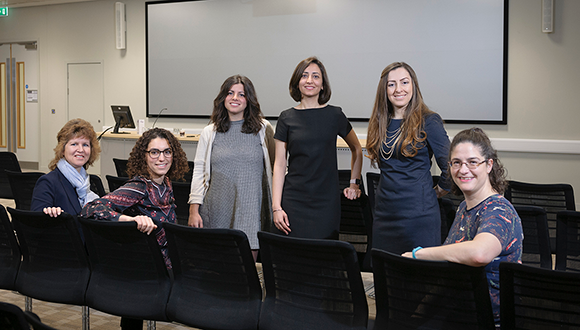Mon, 11 March, 2019
 Farnoosh (centre) and her fellow members of the The Tipper Group Committee. The Tipper Group encourages diversity into engineering and science, by providing inspirational talks and support. Based at TWI Ltd. Photo: NSIRC / TWI Ltd
Farnoosh (centre) and her fellow members of the The Tipper Group Committee. The Tipper Group encourages diversity into engineering and science, by providing inspirational talks and support. Based at TWI Ltd. Photo: NSIRC / TWI Ltd
Farnoosh Farhad settled on her chosen career in high school. With a keen interest in maths and physics, combined with a passion for designing engineering components and solving problems, engineering was a perfect fit.
Pursuing her interests after school in her home country of Iran, Farnoosh completed a Bachelor in Mechanical Engineering, before moving to the UK for a year to study for an MSc in Mechanical Engineering at Newcastle University.
Having achieved a distinction in her MSc, Farnoosh secured employment in industry back in Iran for two years. Whilst there, she discovered a research interest in an industrially orientated PhD. After passing a short course at Imperial College London, she successfully applied for a PhD with NSIRC and TWI Ltd, which she completed in January this year.
The PhD was a fully funded project, sponsored by BP, Coventry University and TWI, researching the effect of sour environments on corrosion pit-to-fatigue crack transition in oil and gas pipelines and predicting this transition time through computational modelling. Farnoosh carried out a series of experimental tests to validate her modelling work, including designing a new environmental test vessel to allow both small-scale corrosion fatigue tests in a toxic environment and X-ray tomography. The proposed prediction model has great potential to be used to develop online inspection tools for a wide range of industries where corrosion pitting impacts structural integrity. TWI anticipate use of the test vessel for further work involving environmental fatigue tests with in-situ X-ray tomography.
BP mentor Roberto Morana said: “Farnoosh has immediately framed the topic within the correct industrial context, gaining the understanding of why what she was about to study would have eventually benefited the industry. With this in her mind, she focused on the fundamental aspects of the phenomenon proposing innovative approaches both from the modelling and experimental point of views. What she has produced will be of advantage for future researchers who will further progress her findings as well as for the industry, who will use the tools she has developed to estimate the remaining life of offshore assets. In addition, Farnoosh has produced high-quality publications published by worldwide recognised scientific journals.”
During her PhD, Farnoosh has won several travel grants to attend and present her research at international conferences, and published two papers in peer-reviewed journals. She was also appointed as a committee member of the Engineering Integrity Society and Honorary Editor of Engineering Integrity Journal.
Reflecting on her time with NSIRC, Farnoosh said: “I really appreciated the research facility at TWI and helpful technicians who were always willing to support me to deliver my test plans on time. NSIRC is the right place to do an industrially oriented PhD, and you can also have fun by joining NSIRC students’ social events. I’d like to thank my TWI supervisor, Dr David Smyth-Boyle, my academic supervisor, Prof Xiang Zhang, and my BP mentor Dr Roberto Morana for their support.”
Following completion of her PhD, Farnoosh will take maternity leave and then plans to apply for a role within academia.
For more information, or to speak to Farnoosh about her research, please contact enquiries@nsirc.co.uk.